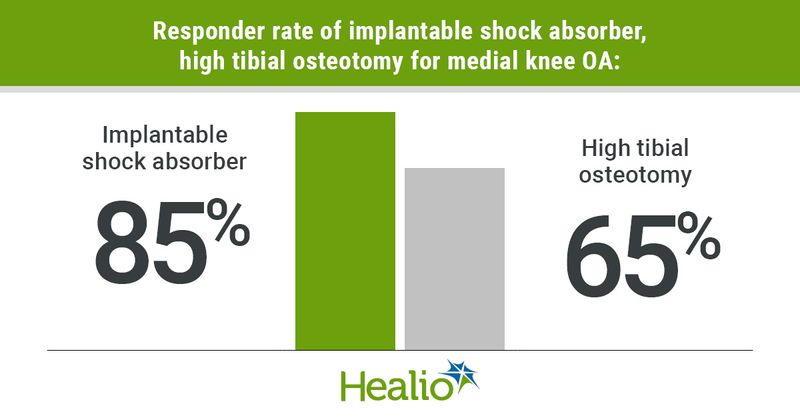Implantable shock absorber may be superior to high tibial osteotomy for medial knee OA
Key takeaways:
- Use of an implantable shock absorber had statistically significant improvements in time to full weight-bearing.
- Nearly two-thirds of patients with an implantable shock absorber returned to an active lifestyle.
LAS VEGAS — Use of an implantable shock absorber may be superior to high tibial osteotomy for patients with medial knee osteoarthritis, according to results presented here.
David C. Flanigan, MD, and colleagues compared improvements in WOMAC pain and function, time to recovery and safety event rates among patients with medial knee OA who received either an implantable shock absorber (n=81; ISA) or high tibial osteotomy (n=81).

“We found that, not only was [the implantable shock absorber] noninferior, but it was superior to high tibial osteotomy with the responder rate of 85% in the ISA group and 65% in the high tibial osteotomy group. This was statistically significant,” Flanigan said in his presentation at the American Academy of Orthopaedic Surgeons Annual Meeting.

Flanigan noted patients in the ISA group had a statistically significant difference in improvement in time to full weight-bearing (2 weeks vs. 6 weeks), as well as improvement in WOMAC pain and function at 3- and 24-month time periods.
“When we looked at the WOMAC pain, there was a reduction in pain that was fast. It was substantial and it was maintained over 24 months,” Flanigan said. “Similarly for function, you can see improvement that was fast. It was substantial, and it was maintained over 24 months.”
He added that the ISA and high tibial osteotomy groups had similar adverse event rates.
“All patients were asked, ‘What are the three activities that you would want to get back to?’ prior to the implantation of this device. At the time, 98% of the patients were unable to perform those activities,” Flanigan said. “By the conclusion of the 2-year time point, nearly two-thirds of patients had regained those activities and were back to an active lifestyle.”

